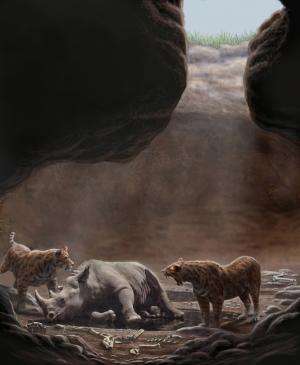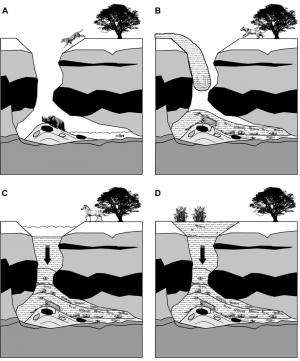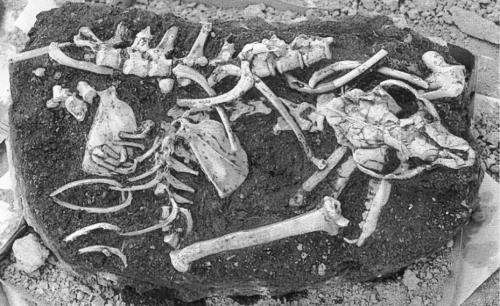Killer entrance suspected in mystery of unusually large group of carnivores in ancient cave

An assortment of saber-toothed cats, hyenas, an extinct 'bear-dog', ancestors of the red panda and several other carnivores died under unusual circumstances in a Spanish cave near Madrid approximately 9-10 million years ago. It now appears that the animals may have entered the cave intentionally and been trapped there, according to research published May 1 in the open access journal PLOS ONE by Soledad Domingo from the University of Michigan and colleagues from other institutions.
Different reasons have previously been offered to explain the unusually large concentration of healthy adult carnivores in this cave, including mass mortality, accidental falls into the cave, or simply that the animals died in other locations and were washed up into the cave. However, none of these could explain the absence of herbivores (nearly 98% of the fossils are of carnivores) or the large numbers of apparently healthy adults.
-

This is the reconstruction of the processes that led to the accumulation of fossil bones in Batallones-1. A) Carnivores intentionally enter into the cave. B) Episodic floods filled the cavity and buried remains in different articulation stages; repeated carnivoran entrances through time. C) Final stages of the filling of the chamber: the location is not a carnivore trap anymore. D) Deposition of elements from the upper level assemblage of Batallones-1 in an uncertain taphonomic context (entrapment of herbivores?). Art by Mauricio Antón, Israel M. Sánchez and M. Soledad Domingo. -

This shows the partially articulated skeleton of the hyena Protictitherium crassum. Credit: PLoS ONE 8(5): e63046. doi:10.1371/journal.pone.0063046
In the present study, authors examined the geological conditions under which the cave was formed, the age of individuals in the cave and the time frame over which they likely entered this pit. Tracking clues like the demography of the individuals recovered, the orientation of the remains and scarcity of fractured bones or trampling marks, among others, the researchers conclude that the animals most likely actively entered the cavity in search of food or water over a protracted period of time and were subsequently unable to make their way out, ultimately dying in the cave. They suggest that the scarcity of herbivore remains may indicate that the cavity was clearly visible and thus avoided by these animals. Fossil bones in this site exhibit a very good preservation state as a consequence of their deposition in the restricted and protective environment of the chamber.
More information: Domingo MS, Alberdi MT, Azanza B, Silva PG, Morales J (2013) Origin of an Assemblage Massively Dominated by Carnivorans from the Miocene of Spain. PLoS ONE 8(5): e63046. doi:10.1371/journal.pone.0063046
Journal information: PLoS ONE
Provided by Public Library of Science




















